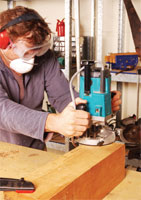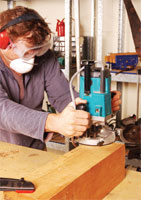
Keys to Effective Programs
Keeping an eye on the essential elements for success simplifies this challenge.
 The simple things employees do every day are what can cause injury, ironically enough. Scalping from someone's hair being wrapped around a shaft or caught in a machine and ripped out is one example. Others are acid or chemical burns, lacerations from bumping into pipes or product being slung at the worker through grinding, and toxic chemical exposures.
The simple things employees do every day are what can cause injury, ironically enough. Scalping from someone's hair being wrapped around a shaft or caught in a machine and ripped out is one example. Others are acid or chemical burns, lacerations from bumping into pipes or product being slung at the worker through grinding, and toxic chemical exposures.
Head and face protection is a fundamental program for the typical workplace. Everyday protection items are the keys, from hair restraints and bump caps to heavy-duty hard hats with chip screens and state-of-the-art laser protection. This PPE runs the gamut and is readily available to protect workers from daily exposures. We often think of head and face protection in the context of construction, and even there, hard hats or safety glasses/goggles may be the extent of our thinking. But those are only the beginning of occupational head and face protection. The safety manager's challenge is having the right items on hand and ensuring each employee understands why it is to be used and does indeed wear it. Otherwise, you have expensive accessories collecting dust and employees exposed to preventable injury.
Program Essentials
• Hazard assessment. Ask your employees which specific exposures they face in the tasks they do. You must ask everyone, simply because every employee does different tasks.
Consider routine tasks and also "one time only" or "once in a while" tasks that may require PPE for head and face protection. Some industries have "once a year" maintenance activities with unique hazards. Others performing infrequent tasks are in-house hurricane or ice storm cleanup crews for your company, who may need extra protection. These can include the workers chipping limbs and grounds workers or others who help out in crisis situations despite being unfamiliar with the duties.
What about your unseen employees? Almost every company has those "ghost" employees who work unseen duties and hours. Remote crews and those with out of sight duties or shifts need protection and top-notch training/education, too.
Investigate the specific tasks and their potential for injury. It is a good idea to have on hand enough face/head protection (and even a spare set or three) in case of a sudden need.
Don't forget upper management. During unusual activities or crisis situations, you will have the big brass and visitors on site. Having upper management and visitors adequately protected sends a strong message to every employee that the company is trying to provide protection to everyone.
• Hazard elimination/control. Eliminating all potential head and face hazards is not a real possibility in most employment situations. Eliminate those you realistically can and protect employees properly for the others or those not anticipated.
Review your worker's compensation cases and injuries. Better yet, discuss the situation in detail with your WC person, who can give you a quick list of injuries and areas to focus on. Review new plans/projects to help eliminate new hazards before they're in place. It takes time and effort but will save in the long run.
•Communication. Without a doubt, explaining the potential for injury to someone working remotely or in the field is one of the toughest parts of any safety professional's job. Each of us balances harshness of fact with reason. It all balances on potential. "I've been doing this for years and have never been injured", "I know what I am doing, don't you worry about me." "Go help someone else," and, my favorite, "When I want safety, I'll call you!" We all get these.
Some years ago, I repeatedly advised an employee to use eye/face protection while working with dangerous chemicals. Each time I checked, the goggles and faceshield were hanging nearby, completely untouched and unmoved. Unfortunately, I could not "prove" this fellow was not using PPE to the satisfaction of the supervisor. Safety can advise employees and supervisors; we usually cannot force them to comply.
Then he sneezed.
He happened to sneeze at the wrong time and splashed caustics on the lower half of his face and over the arm of a summer intern. Luckily, the intern was wearing correct PPE (he had learned from his high school chemistry class) and sustained only minor, although painful, injuries. The employee was burned on the face, neck, and inside his mouth. It was a painful, serious, and quite costly lesson for the company and the employee.
•Training. This is the first step. Reinforce the training and the need for PPE with awareness and education. Videos, handouts, and reminders on the company's Web sites will help to refresh the need for PPE for employees. PPE is an acceptance issue, and it has to come from the top management down to every line employee.
• Enforcement and follow-up. "We're going to miss you!" I often cheerfully tell employees who insist on doing stupid things and who inform me during the argument (with a wicked gleam in their eyes) that I will never know if they indeed wear head/face protection or if they don't.
There are thousands of rationalized reasons not to wear needed and required head and face protection. The reality of it is, none of them will mean anything once the employee is killed or injured. Another harsh reality is that it is tough to feel sympathy for one of these employees who does get hurt. The true sadness is that these "hotdogs" often set an example for others who, not knowing the potential for injury, follow the leader. It is a tragedy when the follower is injured.
New employees are at high risk for such an injury because often they want to please, to fit in, and to follow others on the crew. Sometimes they don't know the proper safety procedures because training has not completed. Your struggle as a safety professional is to educate the new hire and to make sure he/she knows the safe procedures from the beginning. This is not a hope-for-the-best situation.
Who Needs to Wear Head/Face PPE?
Often overlooked or ignored, head and face protection is serious business. Employees rarely see danger in tasks they have done for years without incident. They'll insist they know how to deal with their jobs without critical PPE, and an ignorant employer may be thrilled to save money on PPE and replacements. The truth is, much more is spent on worker's compensation benefits and lost work than on those small purchases of PPE. Most such injuries are preventable.
The simple response to the question posed just above is, "Whoever needs it." Give first consideration to those with active work duties in the company: inspectors under buildings, construction activities, demolition workers, meat cutters/processors, workers who are near machinery with moving parts. Anyone working with chemicals should be high on the list, too. Make it well known that employees can request PPE and how they can contact you (quietly, privately) if their supervisor refuses a purchase.
Set up PPE trials if needed and ask various employees to test-drive a style or type of PPE to see whether it works well. Ask vendors for samples and detailed information on what PPE your type of work usually needs. They have a lot of valuable data that can assist you. All you have to do is ask!
Let's be honest: No one really enjoys wearing PPE. Today's profusion of styles, colors, and comfort do help to make the products more appealing, as do the greater sizing options now available.
By now, you've inspected your work site(s) carefully with a critical eye for contact hazards or have had an outside consultant do it for you. Make sure you look for and ask about falling or flying objects and hanging or moving items that employees may bump into. Consider hazards created during transitions, such as new equipment installation or changes/upgrades. You are trying to prevent the employee from coming into contact with other items and other items from contacting him/her. (There's a big difference in hazards here!)
Training
Train and educate, again and again. This is not a one-time effort, it is continuous.
One of the first things new safety professionals do is to order new PPE for head and face protection, hand it out, and train on how/when to use it. What they often fail to do is any follow-up to ensure the equipment is being used correctly or worn at all. Employees often ignore the PPE, wear it improperly, or discard it without telling anyone if it becomes damaged. The new professional should ask about reorders and how often PPE is requested. While the area supervisor may not even realize there is a problem, the safety professional has the outsider's advantage of zeroing in on the issue and correcting it.
Many accidents that cause head or face injuries are difficult to anticipate or eliminate. Protection begins by anticipating the need through the tasks, through awareness, and through outfitting employees to face the hazards. The actual PPE is the easy part because it is affordable and available; keeping it on the employee is the harder challenge that you can win only by training and education.
It is a constant issue of reinforcement and training and is not an easy task for safety professionals--but let's face it, nothing in safety is very easy! Worth the effort? Yes. Every employee is certainly worth our effort.
This article originally appeared in the November 2007 issue of Occupational Health & Safety.